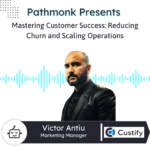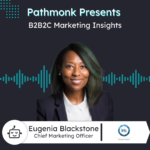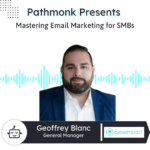App Store Optimization
Introduction
In today’s episode, we talk with David who is the co-founder & CEO of Gummicube – the provider of data, technology, and services for App Store Optimization.
David Bell founded Gummicube with his Co-founder Anh Nguyen in 2010. Gummicube’s proprietary DATACUBE software helps marketers efficiently visualize search and behavioral trends in the App Stores and provides greater competitive insights that enable them to make smarter decisions for their apps more efficiently.
In the podcast, we focus on App Store Optimization and discuss why is important to focus on this when you run an app-based business and are a mobile marketer. We also discussed their own SEO and website strategies and how they find clients. Check it out…
See an abstract of the interview below…
Pathmonk: You mentioned the website there and the conversion rate on the website. Could you tell me about the overall role of the website for your business? Is it a key element? How does it play in the whole setup of coming here?
Dave Bell: It’s a key element. We are somewhat unique in our industry and that our business model is not just kind of sign up online free trial to paid. Our business model is SaaS, but people will contact us like more of a business development kind of relationship. We’ll walk them through the product, kind of do some solution selling, understand what their issues are. Typically when people sign up, they get access to the technology and also an account manager to kind of help them execute and achieve the best results. So it’s a little beyond customer success. So, that’s what I, that’s why I say, our objective is to kind of communicate that value. Have someone reach out to us and then, be able to kind of explain kind of what the value proposition is. A lot of our clients, I would say maybe 50% of our clients right now are startups that are very serious about their business and maybe people who are, they’ve raised their seed, they raised their series a, they’re scaling. The other half are enterprise companies. If you look at the top 10 apps in every category of the app store play store, we’re working with at least three or four of those guys.
Pathmonk: Usually we talk with SaaS business owners about the types of metrics that actually drive their decision making.There is a bunch of metrics out there, the traffic that you get, the time that they spend on page, the bounce rate, the time on page, I guess I said before, the conversion rate signups, what is it really that you’d take close to heart to make decisions?
Dave Bell: Yes. We do a lot of testing on our website and a lot of testing with our messaging and kind of, we have different objectives throughout the funnel. The initial objective is, what would cause a user who is visiting our website to shoot us an email, right.And contact us. Right that’s number one. So, we do AB test a lot of messaging in terms of, what features do people kind of react with the most urgency around and what is the messaging around those features? How frequently and where are we placing contact buttons through the site? Kind of what messaging works best from a research perspective versus what messaging is working best from a call to action perspective? We already know that there’s a lot of market demand around our products and features and we take the approach that, there are a lot of layers to the conversion on nd instead of making big radical changes and testing those, we prefer to kind of peel off one layer of it and at the time and test like a feature and then test messaging and then test maybe the color of the contact button and those are the kind of things, that we really work on.We’re fortunate we’ve been doing this for 10 years, so we’re very established in our space so there’s a lot brand recognition already.For us it’s really understanding kind of, how those little things will move the needle.
Pathmonk: Anything that you learned that was surprising to yourself or like a little war story in terms of conversion rate optimization where learn something maybe that was even surprising yourself?
Dave Bell: I was always a believer. I mean this is just kind of anecdotal, right? I was always a believer in terms of like placements of contact buttons on websites, right? And, there’s a lot of AB testing and research around that, right? Upper right hand corner is really important.Then, but I wasn’t as much a believer in color, right? And kind of how that can impact things. We did a lot of AB testing, with colors on the website and as you can see, we have a lot of contact us buttons there. What we found was that the difference between like a bright orange button, which I thought would be much better because it stands out in the current button that we’re using now, which is green was about 30% improvement in conversion, at least for our website. It was fairly significant and what we learned from our customers when we talk to them because we often, we’ll have kind of a post signup discussion and sometimes I jump on and we do a little survey and say, Hey, what caused you to reach out? What we learned was that the brighter colors made them feel, almost like it could be like a kind of a car salesman experience. It’s like higher pressure for them psychologically. The colors that were maybe a little, they stood out from the websites. They were easy to read and very crisp, but maybe more muted, made them feel like it was more of a, were going to educate them kind of experience. It was interesting because they associated that with the content on our webpage and that was one of the first things people brought up. We’ve learned that psychology is really important and the colors that you use, have direct associations into how people think you might interact with them if you’re going to reach out, right. Styles and layouts in a very similar way.We take all of that really seriously.
Pathmonk: Interesting because, I hear in our interviews that we running a lot of the times the color test gets dismissed right. As the typical one that you shouldn’t do. You’re showing us a very interesting example here where sticking to it and really following up and learning why people go for it can actually be very beneficial.
(…)












